Artificial Water Troughs Use by the Mountain Ungulate Ovis gmelini ophion (Cyprus Mouflon) at Pafos Forest
Abstract
:Simple Summary
Abstract
1. Introduction
2. Materials and Methods
2.1. Study Area
2.2. Field Work Design
2.3. Data Analyses
3. Results
4. Discussion
5. Conclusions
Author Contributions
Funding
Institutional Review Board Statement
Informed Consent Statement
Data Availability Statement
Acknowledgments
Conflicts of Interest
Appendix A
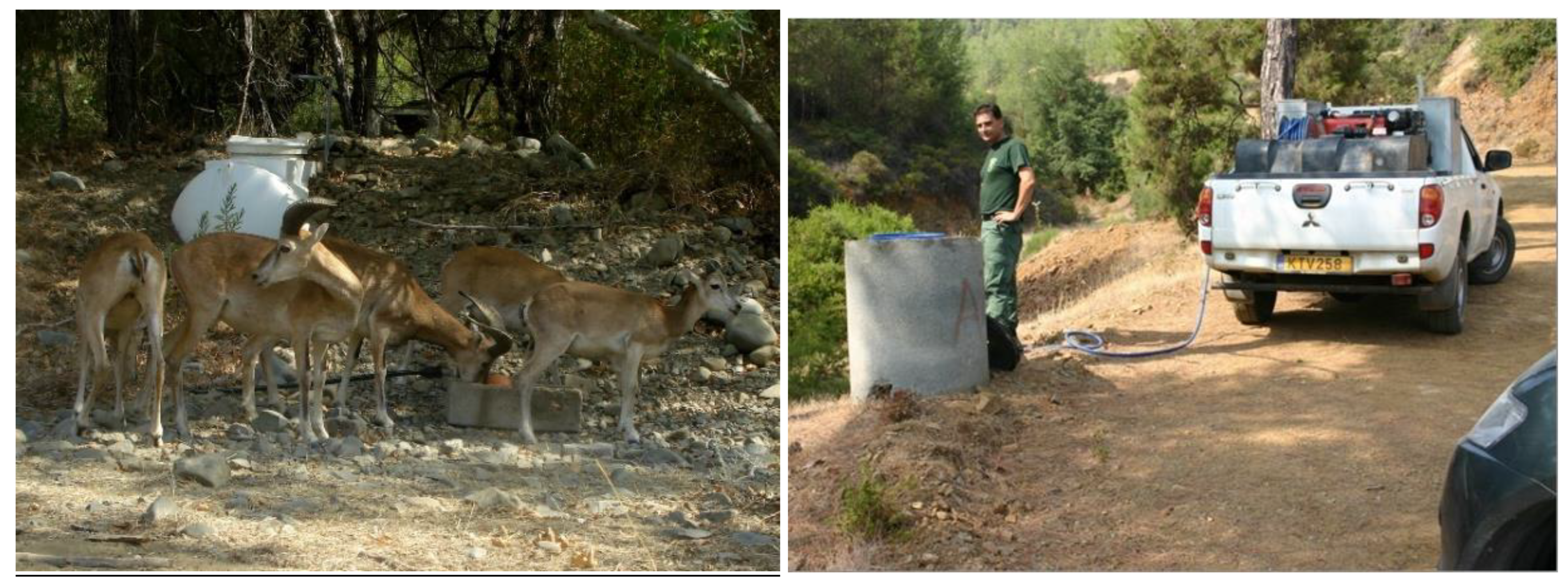

Appendix B
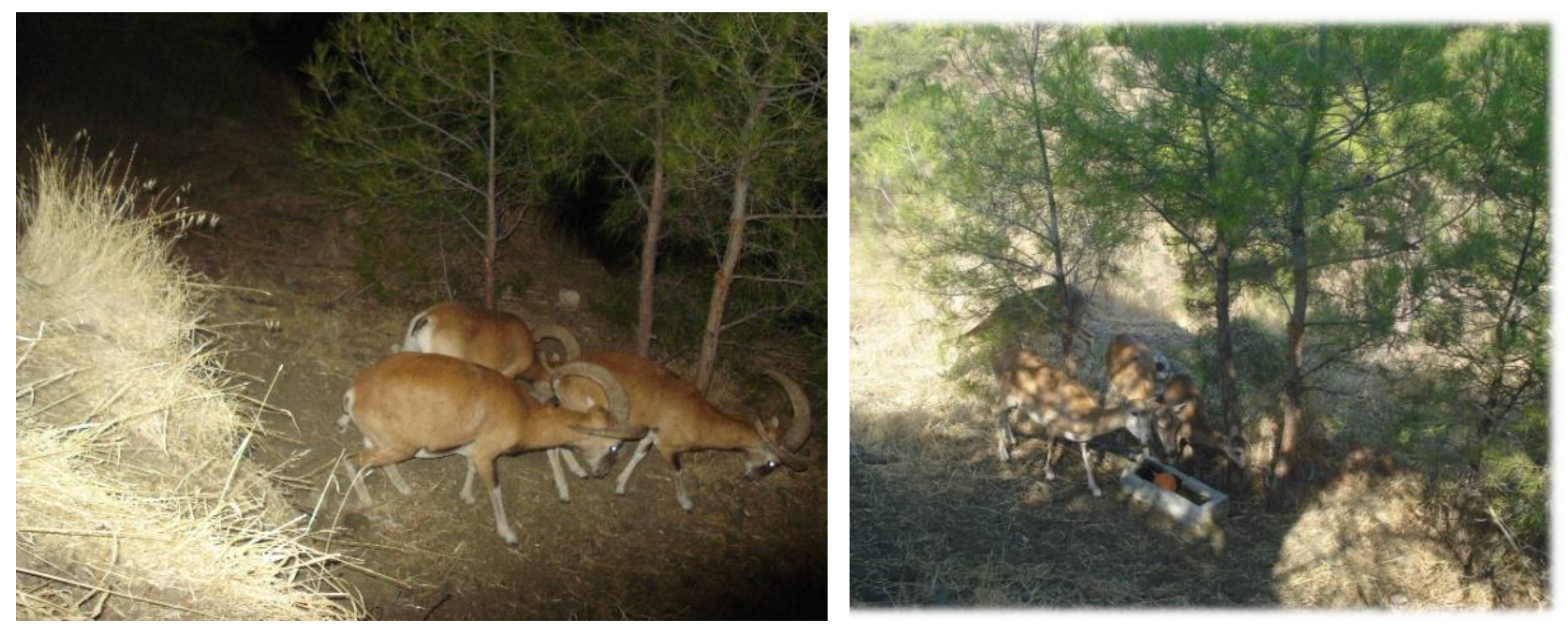
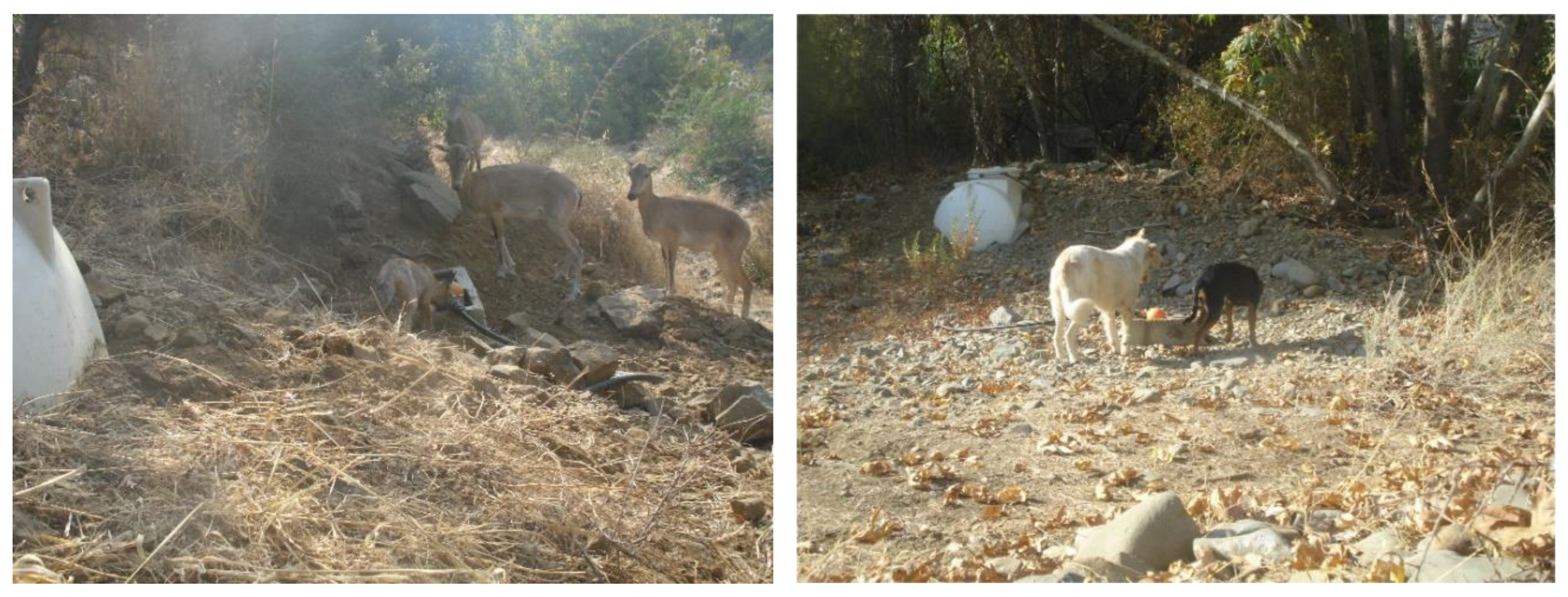
Appendix C
| Variable | Description | Temporal Scale * |
|---|---|---|
| elevation | continuous; elevation at the site of the camera trap | day, week |
| southern exposure | continuous; estimated as percent of area within a 1 km ** radius from the camera trap that has southern exposure (i.e., aspect between 90 and 270°) | day, week |
| open area *** | continuous; per cent of non-forested (open) area within a 2 km *** radius from the monitored water trough | day, week |
| distance to forage | continuous; log of distance to the nearest forage patch sown by the Game and Fauna Service to provide bedding and food to the mouflon (only areas >100 m2 used) | day, week |
| distance to terrace/cliff | continuous; log of distance to from the artificial water trough to the edge of the nearest terrace, cliff or rocky outcrop, where the mouflon can seek shelter if threatened | day, week |
| distance to closest water trough | continuous; log of distance to the nearest water trough | day, week |
| mean distance to the three closest water troughs | continuous; log of the mean distance to the three closest water troughs | day, week |
| water troughs within 2 km radius | continuous; number of water troughs within a 2 km *** radius from the monitored water trough | day, week |
| distance to roads | continuous; log of distance to the nearest paved (tarred) road | day, week |
| temp (mean 24 h) | continuous; mean of 24 hourly temperature measurements | day |
| temp (max 24 h) | continuous; maximum of 24 hourly temperature measurements | day |
| temp (min 24 h) | continuous; minimum of 24 hourly temperature measurements | day |
| temp (weekly mean) | continuous; mean of seven daily mean temperatures | week |
| temp (mean 24 h max) | continuous; mean of seven daily maximum temperatures | week |
| temp (mean 24 h min) | continuous; mean of seven daily minimum temperatures | week |
| precipitation (24 h) | continuous; total daily precipitation (mm) | day |
| precipitation (past 7-days) | continuous; total precipitation (mm) of a day and the six preceding days | day |
| precipitation (weekly total) | continuous; total precipitation (mm) of a given week (Monday–Sunday) | week |
| mouflon density | continuous; range 1–5 (1–3, 3–5, 5–7, 7–9, 9–10 mouflon per km2 density estimate, based on 2016 transect surveys) | day, week |
| periphery | categorical; whether the monitored water trough is located at the core (0) or the periphery (1) of the Pafos Forest | day, week |
| hunting day | categorical; whether hunting was permitted within the study area on the given date (1) or not (0) | day |
| hunting site | categorical; whether the monitored water trough is located within a no-hunting (0) or a hunting (1) zone | day, week |
| time of day | categorical; time of the day during which mouflon presence at a water trough was detected by the camera traps: early morning 00:00–6:00, late morning 6:00–12:00, midday 12:00–18:00, and evening 18:00–00:00 | day |
References
- Morgart, J.R.; Hervert, J.J.; Krausman, P.R.; Bright, J.L.; Henry, R.S. Sonoran pronghorn use of anthropogenic and natural water sources. Wildl. Soc. Bull. 2005, 33, 51–60. [Google Scholar] [CrossRef]
- Epaphras, A.M.; Gereta, E.; Lejora, I.A.; Ole Meing’ataki, G.E.; Ng’umbi, G.; Kiwango, Y.; Mwangomo, E.; Semanini, F.; Vitalis, L.; Balozi, J.; et al. Wildlife water utilization and importance of artificial waterholes during dry season at Ruaha National Park, Tanzania. Wetl. Ecol. Manag. 2008, 16, 183–188. [Google Scholar] [CrossRef]
- Smit, I.P.J.; Grant, C.C.; Devereux, B.J. Do artificial waterholes influence the way herbivores use the landscape? Herbivore distribution patterns around rivers and artificial surface water sources in a large African savanna park. Biol. Conserv. 2007, 136, 85–99. [Google Scholar] [CrossRef]
- Smit, I.P.J.; Grant, C.C. Managing surface-water in a large semi-arid savanna park: Effects on grazer distribution patterns. J. Nat. Conserv. 2009, 17, 61–71. [Google Scholar] [CrossRef]
- Harris, G.; Sanderson, J.G.; Erz, J.; Lehnen, S.E.; Butler, M.J. Weather and prey predict mammals’ visitation to water. PLoS ONE 2015, 10, e0141355. [Google Scholar] [CrossRef] [PubMed] [Green Version]
- Letnic, M.; Laffan, S.W.; Greenville, A.C.; Russell, B.G.; Mitchell, B.; Fleming, P.J.S. Artificial watering points are focal points for activity by an invasive herbivore but not native herbivores in conservation reserves in arid Australia. Biodivers. Conserv. 2015, 24, 1–16. [Google Scholar] [CrossRef]
- Sutherland, K.; Ndlovu, M.; Pérez-Rodríguez, A. Use of artificial waterholes by animals in the southern region of the Kruger National Park, South Africa. Afr. J. Wildl. Res. 2018, 48, 1–14. [Google Scholar] [CrossRef]
- Lamprey, R.H.; Reid, R.S. Expansion of human settlement in Kenya’s Maasai Mara: What future for pastoralism and wildlife? J. Biogeogr. 2004, 31, 997–1032. [Google Scholar] [CrossRef]
- Ogutu, J.O.; Piepho, H.; Dublin, H.T.; Bhola, N.; Reid, R.S. Dynamics of Mara–Serengeti ungulates in relation to land use changes. J. Zool. 2009, 278, 1–14. [Google Scholar] [CrossRef]
- Selebatso, M.; Bennitt, E.; Maude, G.; Fynn, R.W.S. Water provision alters wildebeest adaptive habitat selection and resilience in the Central Kalahari. Afr. J. Ecol. 2018, 56, 225–234. [Google Scholar] [CrossRef]
- Rosenstock, S.S.; Ballard, W.B.; DeVos, J.C. benefits and impacts of wildlife water developments. Rangel. Ecol. Manag. Range Manag. Arch. 1999, 52, 302–311. [Google Scholar] [CrossRef]
- Cain, J.W.; Krausman, P.R.; Rosenstock, S.S.; Turner, J.C. Mechanisms of Thermoregulation and Water Balance in Desert Ungulates. Wildl. Soc. Bull. 2006, 34, 570–581. [Google Scholar] [CrossRef]
- Rispel, M.; Lendelvo, S. The utilization of water points by wildlife species in Nyae Nyae Conservancy, Namibia. Environ. Nat. Resour. Res. 2016, 6, 91–103. [Google Scholar] [CrossRef]
- Valdez, R.; Krausman, P.R. Mountain Sheep of North America; University of Arizona Press: Tucson, AZ, USA, 1999; ISBN 0816518394. [Google Scholar]
- Elder, J.B. Watering patterns of some desert game animals. J. Wildl. Manag. 1956, 20, 368–378. [Google Scholar] [CrossRef]
- Pimentel, D.; Berger, B.; Filiberto, D.; Newton, M.; Wolfe, B.; Karabinakis, E.; Clark, S.; Poon, E.; Abbett, E.; Nandagopal, S. Water resources: Agricultural and environmental issues. Bioscience 2004, 54, 909–918. [Google Scholar] [CrossRef] [Green Version]
- Owen-Smith, N. Ecological guidelines for waterpoints in extensive protected areas. South Afr. J. Wildl. Res. 1996, 26, 107–112, delayed open access. [Google Scholar]
- Harrington, R.; Owen-Smith, N.; Viljoen, P.C.; Biggs, H.C.; Mason, D.R.; Funston, P. Establishing the causes of the roan antelope decline in the Kruger National Park, South Africa. Biol. Conserv. 1999, 90, 69–78. [Google Scholar] [CrossRef]
- Harris, G.M.; Stewart, D.R.; Brown, D.; Johnson, L.; Sanderson, J.; Alvidrez, A.; Waddell, T.; Thompson, R. Year-round water management for desert bighorn sheep corresponds with visits by predators not bighorn sheep. PLoS ONE 2020, 15, e0241131. [Google Scholar] [CrossRef]
- Buitenwerf, R.; Swemmer, A.M.; Peel, M.J.S. Long-term dynamics of herbaceous vegetation structure and composition in two African savanna reserves. J. Appl. Ecol. 2011, 48, 238–246. [Google Scholar] [CrossRef] [Green Version]
- Fullman, T.J.; Bunting, E.L.; Kiker, G.A.; Southworth, J. Predicting shifts in large herbivore distributions under climate change and management using a spatially-explicit ecosystem model. Ecol. Modell. 2017, 352, 1–18. [Google Scholar] [CrossRef]
- Perkins, J.S. Changing the Scale and Nature of Artificial Water Points (AWP) Use and Adapting to Climate Change in the Kalahari of Southern Africa. In Sustainability in Developing Countries; Springer: Berlin/Heidelberg, Germany, 2020; pp. 51–89. [Google Scholar]
- Mella, V.S.A.; McArthur, C.; Krockenberger, M.B.; Frend, R.; Crowther, M.S. Needing a drink: Rainfall and temperature drive the use of free water by a threatened arboreal folivore. PLoS ONE 2019, 14, e0216964. [Google Scholar] [CrossRef] [PubMed]
- Diffenbaugh, N.S.; Giorgi, F. Climate change hotspots in the CMIP5 global climate model ensemble. Clim. Change 2012, 114, 813–822. [Google Scholar] [CrossRef] [PubMed] [Green Version]
- Zittis, G.; Hadjinicolaou, P.; Klangidou, M.; Proestos, Y.; Lelieveld, J. A multi-model, multi-scenario, and multi-domain analysis of regional climate projections for the Mediterranean. Reg. Environ. Chang. 2019, 19, 2621–2635. [Google Scholar] [CrossRef] [Green Version]
- Hadjinicolaou, P.; Giannakopoulos, C.; Zerefos, C.; Lange, M.A.; Pashiardis, S.; Lelieveld, J. Mid-21st century climate and weather extremes in Cyprus as projected by six regional climate models. Reg. Environ. Chang. 2011, 11, 441–457. [Google Scholar] [CrossRef]
- Kassinis, N.I.; Ioannou, I.; Mammides, C.; Panayides, P.; Nicolaou, K. Current status, population dynamics and causes of mortality in Cyprus mouflon. In Proceedings of the 6th World Congress on Mountain Ungulates and 5th International Symposium on Mouflon, Nicosia, Cyprus, 29 August–1 September 2016; p. 41. [Google Scholar]
- Hadjisterkotis, E.; Nahlik, A.; Uloth, W. The Cyprus mouflon, a threatened species in a biodiversity “hotspot” area. In Proceedings of the Third International Symposium on Mouflon, Sopron, Hungary, 27–29 October 2001; pp. 71–81. [Google Scholar]
- Kassinis, N.; Xenophontos, M. Population status and conservation of the Cyprus Mouflon (Ovis gmelini ophion): 10 years of monitoring. In Proceedings of the Abstracts of the International Congress on the Zoogeography, Ecology and Evolution of Eastern Mediterranean, 11th ICZEGAR, Herakleion, Greece, 21–25 September 2009; p. 46. [Google Scholar]
- Michel, S.; Ghoddousi, A. Ovis gmelini. The IUCN Red List of Threatened Species 2020; E. T54940218A22147055; IUCN: Gland, Switzerland, 2020. [Google Scholar]
- Nicolaou, H.; Hadjisterkotis, E.; Sparrow, D.J.; Sparrow, R. Mammals. In An Introduction to the Wildlife of Cyprus; Sparrow, D.J., Eddie, J., Eds.; Terra Cypria: Limassol, Cyprus, 2016; p. 870. [Google Scholar]
- Sfougaris, A. Management Plan for the Cypriot Mouflon (Ovis orientalis Ophion). Edition of the Project “Preparation of an Integrated Management Plan for the Paphos Forest”; Ministry of Agriculture, Natural Resources and Environment, Department of Forests: Nicosia, Cyprus, 2011. (In Greek)
- Fischer, A.; Kaiser, T.; Pickert, J.; Behrendt, A. Studies on drinking water intake of fallow deer, sheep and mouflon under semi-natural pasture conditions. Grassl. Sci. 2017, 63, 46–53. [Google Scholar] [CrossRef] [Green Version]
- Nadazdin, M.; Radivojevic, R.; Jakobcic, Z.; Durica, G. Elements of regressive deficit and diet of mouflon game in the submediterranean region of Montenegro and Herzegovina. Vet. Glas. 1996, 50, 171–176. [Google Scholar]
- Hadjisterkotis, E. Gefahren für das Zyprische Mufflon aufgrund des Vorkommens als einzelne Restpopulation in einem einzigen Verbreitungsgebiet. Z. Jagdwiss. 1999, 45, 27–34. (In German) [Google Scholar] [CrossRef]
- Hadjisterkotis, E. Population, ecology and food habits of the Cyprus mouflon. In Proceedings of the 6th World Congress on Mountain Ungulates and 5th International Symposium on Mouflon Book of Abstract, Nicosia, Cyprus, 29 August–1 September 2016; Hadjisterkotis, E., Ed.; 2016; p. 37. [Google Scholar]
- Malek, E.; McCurdy, G.; Giles, B. Dew contribution to the annual water balances in semi-arid desert valleys. J. Arid Environ. 1999, 42, 71–80. [Google Scholar] [CrossRef]
- Agam, N.; Berliner, P.R. Dew formation and water vapor adsorption in semi-arid environments—A review. J. Arid Environ. 2006, 65, 572–590. [Google Scholar] [CrossRef]
- Brivio, F.; Ciuti, S.; Pipia, A.; Grignolio, S.; Apollonio, M. Livestock displace European mouflon from optimal foraging sites. Eur. J. Wildl. Res. 2022, 68, 1–10. [Google Scholar] [CrossRef]
- Gatzogiannis, S.; Palaskas, D.; Tsiaras, D.; Konstantinides, P.; Tsiourlis, G.; Kassioumis, Κ.; Theofanous, S.; Sfougaris, A.; Georgiakakis, P.; Poirazides, Κ.; et al. Management Plan of the Pafos Forest; Ministry of Agriculture, Natural Resources and Environment, Department of Forest: Nicosia, Cyprus, 2010. (In Greek)
- Ι.A.CO Environmental and Water Consultants, Ltd.; BirdLife-Cyprus. Game and Fauna Service Management Plan of ZEP “Dasos Pafou”; Ministry of Interior, Game and Fauna Services: Nicosia, Cyprus, 2016. (In Greek)
- Hadjisterkotis, E.S.; Bider, J.R. Reproduction of Cyprus mouflon Ovis gmelini ophion in captivity and in the wild. Int. Zoo Yearb. 1993, 32, 125–131. [Google Scholar] [CrossRef]
- Le Pendu, Y.; Briedermann, L.; Gerard, J.-F.; Maublanc, M.-L. Inter-individual associations and social structure of a mouflon population (Ovis orientalis musimon). Behav. Processes 1995, 34, 67–80. [Google Scholar] [CrossRef]
- Hadjisterkotis, E.; Bider, J.R. Wild Sheep and Goats and Their Relatives: Status Survey and Conservation Action Plan for Caprinae; Shackleton, D.M., Ed.; IUCN Caprinae Specialist Group: Gland, Switzerland; Cambridge, UK, 1997; pp. 89–92. [Google Scholar]
- Pin, C.; Ngoprasert, D.; Gray, T.N.E.; Savini, T.; Crouthers, R.; Gale, G.A. Utilization of waterholes by globally threatened species in deciduous dipterocarp forest of the Eastern Plains Landscape of Cambodia. Oryx 2020, 54, 572–582. [Google Scholar] [CrossRef]
- López-Téllez, C.; Pérez-Irineo, G.; Mandujano, S.; Ramírez-Carmona, G.; Hernández-Gómez, C.A.; Flores-Ramírez, D.E. Vertebrates visiting natural waterholes in a tropical seasonal habitat in central México. Therya Notes 2021, 2, 89–93. [Google Scholar] [CrossRef]
- Glen, A.S.; Cockburn, S.; Nichols, M.; Ekanayake, J.; Warburton, B. Optimising camera traps for monitoring small mammals. PLoS ONE 2013, 8, e67940. [Google Scholar] [CrossRef]
- Edwards, S.; Noack, J.; Heyns, L.; Rodenwoldt, D. Are camera traps a reliable method for estimating activity patterns? A case study comparing technologies for estimating brown hyaena activity curves. Remote Sens. Ecol. Conserv. 2021, 7, 129–138. [Google Scholar] [CrossRef]
- Maisels, F.G. The feeding ecology of the Cyprus mouflon Ovis orientalis Gmelin 1774, in the Paphos forest, Cyprus. Diss. Abstr. Int. B Sci. Eng. 1990, 51, 3201B. [Google Scholar]
- Bates, D.; Mächler, M.; Bolker, B.; Walker, S. Fitting linear mixed-effects models using lme4. arXiv 2014, arXiv:1406.5823. [Google Scholar]
- Hartig, F. DHARMa: Residual Diagnostics for Hierarchical (Multi-Level / Mixed) Regression Models. R package version 0.4.6. Available online: http://florianhartig.github.io/DHARMa/ (accessed on 22 March 2022).
- Hadjisterkotis, E.S. The Cyprus Mouflon (Ovis gmelini ophion): Management, Conservation and Evolution; McGill University: Montréal, QC, USA, 1992. [Google Scholar]
- Burnham, K.P.; Anderson, D.R. (Eds.) Statistical Theory and Numerical Results BT—Model Selection and Multimodel Inference: A Practical Information-Theoretic Approach; Springer: New York, NY, USA, 2002; pp. 352–436. ISBN 978-0-387-22456-5. [Google Scholar]
- Bartoń, K.; MuMIn: Multi-model inference. R package version 1.43.17. 2020. Available online: https://CRAN.R-project.org/package=MuMIn (accessed on 30 May 2021).
- Byrnes, J. [R-sig-ME] Coefficient of Determination (R^2) When Using lme(). Available online: https://stat.ethz.ch/pipermail/r-sig-mixed-models/2008q2/000713.html (accessed on 22 March 2022).
- Meredith, M.; Ridout, M. Overview of the Overlap Package. Available online: https://cran.r-project.org/web/packages/overlap/vignettes/overlap.pdf (accessed on 12 June 2022).
- Ridout, M.S.; Linkie, M. Estimating overlap of daily activity patterns from camera trap data. J. Agric. Biol. Environ. Stat. 2009, 14, 322–337. [Google Scholar] [CrossRef]
- Whiting, J.C.; Bowyer, R.T.; Flinders, J.T. Diel Use of Water by Reintroduced Bighorn Sheep. West. N. Am. Nat. 2009, 69, 407–412. [Google Scholar] [CrossRef] [Green Version]
- Turner, J.C.; Weaver, R.A. Water. In The Desert Bighorn: Its Life History, Ecology, and Management; Monson, G., Sumner, L., Eds.; The University of Arizona Press: Tucson, AZ, USA, 1980; pp. 100–112. [Google Scholar]
- Kasiringua, E.; Kopij, G.; Procheş, Ş. Daily activity patterns of ungulates at water holes during the dry season in the Waterberg National Park, Namibia. Russ. J. Theriol. 2017, 16, 129–138. [Google Scholar] [CrossRef]
- Turner, J.C. Water, Energy and Electrolyte Balance in the Desert Bighorn Sheep, Ovis canadensis. University of California: Riverside, CA, USA, 1973. [Google Scholar]
- Robbins, C.T. Wildlife Feeding and Nutrition: Animanl Deefing and Nutrition—A Series of Monographs; Cunha, T.J., Miller, W.J., Perry, T.W., Robbins, C.T., Eds.; Academic Press: San Diego, CA, USA, 1993. [Google Scholar]
- Turner, J.C.; Douglas, C.L.; Hallum, C.R.; Krausman, P.R.; Ramey, R.R. Determination of critical habitat for the endangered Nelson’s bighorn sheep in Southern California. Wildl. Soc. Bull. 2004, 32, 427–448. [Google Scholar] [CrossRef]
- Marshal, J.P.; Krausman, P.R.; Bleich, V.C.; Rosenstock, S.S.; Ballard, W.B. Gradients of Forage Biomass and Ungulate Use near Wildlife Water Developments. Wildl. Soc. Bull. 2006, 34, 620–626. [Google Scholar] [CrossRef]
- Bourgoin, G.; Garel; Blanchard; Dubray, D.; Maillard, D.; Gaillard, J.-M. Daily responses of mouflon activity to summer climatic conditions. Can. J. Zool. 2011, 89, 765–773. [Google Scholar] [CrossRef]
- Centore, L.; Ugarković, D.; Scaravelli, D.; Safner, T.; Pandurić, K.; Šprem, N. Locomotor activity pattern of two recently introduced non-native ungulate species in a Mediterranean habitat. Folia Zool. 2018, 67, 17–24. [Google Scholar] [CrossRef]
- Ciuti, S.; Luchetti, S.; Pipia, A.P.; Apollonio, M.; Grignolio, S.; Madau, R. Influence of sex, season, temperature and reproductive status on daily activity patterns in Sardinian mouflon (Ovis orientalis musimon). Behaviour 2008, 145, 1723–1745. [Google Scholar] [CrossRef] [Green Version]
- Ohashi, H.; Saito, M.; Horie, R.; Tsunoda, H.; Noba, H.; Ishii, H.; Kuwabara, T.; Hiroshige, Y.; Koike, S.; Hoshino, Y.; et al. Differences in the activity pattern of the wild boar Sus scrofa related to human disturbance. Eur. J. Wildl. Res. 2013, 59, 167–177. [Google Scholar] [CrossRef]
- Lewis, J.S.; Spaulding, S.; Swanson, H.; Keeley, W.; Gramza, A.R.; VandeWoude, S.; Crooks, K.R. Human activity influences wildlife populations and activity patterns: Implications for spatial and temporal refuges. Ecosphere 2021, 12, e03487. [Google Scholar] [CrossRef]
- Barrueto, M.; Ford, A.T.; Clevenger, A.P. Anthropogenic effects on activity patterns of wildlife at crossing structures. Ecosphere 2014, 5, art27. [Google Scholar] [CrossRef]
- Sungirai, M.; Ngwenya, M. An Investigation into the Efficiency of Utilization of Artificial Game Water Supplies by Wildlife Species in the North Eastern Kalahari Region of Hwange National Park in Zimbabwe. Appl. Ecol. Environ. Sci. 2016, 4, 7–14. [Google Scholar] [CrossRef]
- Knight, M.H. Importance of borehole water to doves and sandgrouse in the semi-arid southern Kalahari. South Afr. J. Wildl. Res. 1989, 19, 42–46. [Google Scholar]
- Burger, J. Visibility, group size, vigilance, and drinking behavior in coati (Nasua narica) and white-faced capuchins (Cebus capucinus): Experimental evidence. Acta Ethol. 2001, 3, 111–119. [Google Scholar] [CrossRef]
- Valeix, M.; Fritz, H.; Dubois, S.; Kanengoni, K.; Alleaume, S.; Saïd, S. Vegetation Structure and Ungulate Abundance over a Period of Increasing Elephant Abundance in Hwange National Park, Zimbabwe. J. Trop. Ecol. 2007, 23, 87–93. [Google Scholar] [CrossRef] [Green Version]
- Valeix, M.; Fritz, H.; Loveridge, A.J.; Davidson, Z.; Hunt, J.E.; Murindagomo, F.; Macdonald, D.W. Does the risk of encountering lions influence African herbivore behaviour at waterholes? Behav. Ecol. Sociobiol. 2009, 63, 1483–1494. [Google Scholar] [CrossRef]
- Tadesse, S.A.; Kotler, B.P. Habitat Choices of Nubian Ibex (Capra nubiana) Evaluated with A habitat Suitability Modeling and Isodar Analysis. Isr. J. Ecol. Evol. 2010, 56, 55–74. [Google Scholar] [CrossRef]
- Auslander, M.; Nevo, E.; Inbar, M. The effects of slope orientation on plant growth, developmental instability and susceptibility to herbivores. J. Arid Environ. 2003, 55, 405–416. [Google Scholar] [CrossRef]
- Thrash, I.; Derry, J.F. The nature and modelling of piospheres: A review. Koedoe African Prot. Area Conserv. Sci. 1999, 42, 73–94. [Google Scholar] [CrossRef]
- Kassinis, N.; Ioannou, I.; Nicolaou, N. Mortality Causes of the Cyprus mouflon Ovis orientalis ophion, 2001–2010 . In Proceedings of the XXX IUGB Congress and Perdix XIII; 5–9 September 2011, Puigcerver, M., Teijeiro, J.D.R., Buner, F., Eds.; International Union of Game Biologists (IUGB): Barcelona, Spain, 2012; p. 280. [Google Scholar]
- Rois-Díaz, M.; Lovric, N.; Lovric, M.; Ferreiro-Domínguez, N.; Mosquera-Losada, M.R.; den Herder, M.; Graves, A.; Palma, J.H.N.; Paulo, J.A.; Pisanelli, A.; et al. Farmers’ reasoning behind the uptake of agroforestry practices: Evidence from multiple case-studies across Europe. Agrofor. Syst. 2018, 92, 811–828. [Google Scholar] [CrossRef] [Green Version]
- Davidson, Z.; Valeix, M.; Van Kesteren, F.; Loveridge, A.J.; Hunt, J.E.; Murindagomo, F.; Macdonald, D.W. Seasonal Diet and Prey Preference of the African Lion in a Waterhole-Driven Semi-Arid Savanna. PLoS ONE 2013, 8, e55182. [Google Scholar] [CrossRef] [Green Version]
- Ciuti, S.; Pipia, A.; Grignolio, S.; Ghiandai, F.; Apollonio, M. Space use, habitat selection and activity patterns of female Sardinian mouflon (Ovis orientalis musimon) during the lambing season. Eur. J. Wildl. Res. 2009, 55, 589–595. [Google Scholar] [CrossRef]
- Payne, A.; Philipon, S.; Hars, J.; Dufour, B.; Gilot-Fromont, E. Wildlife Interactions on Baited Places and Waterholes in a French Area Infected by Bovine Tuberculosis. Front. Vet. Sci. 2017, 3, 122. [Google Scholar] [CrossRef] [PubMed] [Green Version]
- Titcomb, G.; Mantas, J.N.; Hulke, J.; Rodriguez, I.; Branch, D.; Young, H. Water sources aggregate parasites with increasing effects in more arid conditions. Nat. Commun. 2021, 12, 7066. [Google Scholar] [CrossRef] [PubMed]
- Webb, E.B.; McArthur, C.; Woolfenden, L.; Higgins, D.P.; Krockenberger, M.B.; Mella, V.S.A. Risk of predation and disease transmission at artificial water stations. Wildl. Res. 2022, 49, 324–334. [Google Scholar] [CrossRef]
- Kapnisis, K.; Kassinis, N.; Papanikolopoulou, V.; Diakou, A. Endoparasites in wild populations of Cyprus mouflon (Ovis gmelini ophion). Vet. Parasitol. Reg. Stud. Rep. 2022, 34, 100767. [Google Scholar] [CrossRef] [PubMed]
- Gortazar, C.; Diez-Delgado, I.; Barasona, J.A.; Vicente, J.; De La Fuente, J.; Boadella, M. The Wild Side of Disease Control at the Wildlife-Livestock-Human Interface: A Review. Front. Vet. Sci. 2015, 1, 27. [Google Scholar] [CrossRef] [PubMed]
- Giannakopoulos, C.; Hadjinicolaou, P.; Kostopoulou, E.; Varotsos, K.V.; Zerefos, C. Precipitation and temperature regime over Cyprus as a result of global climate change. Adv. Geosci. 2010, 23, 17–24. [Google Scholar] [CrossRef]
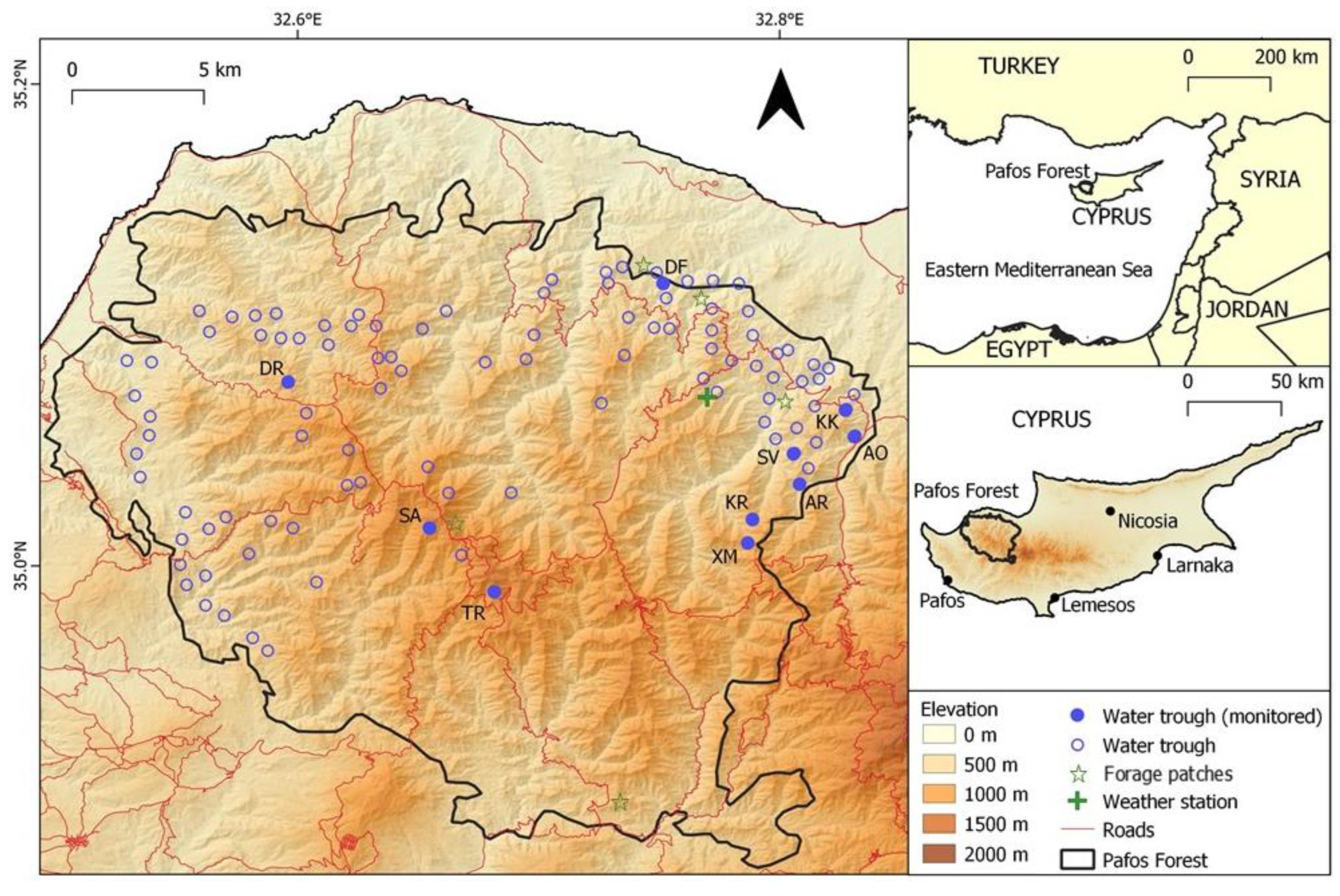
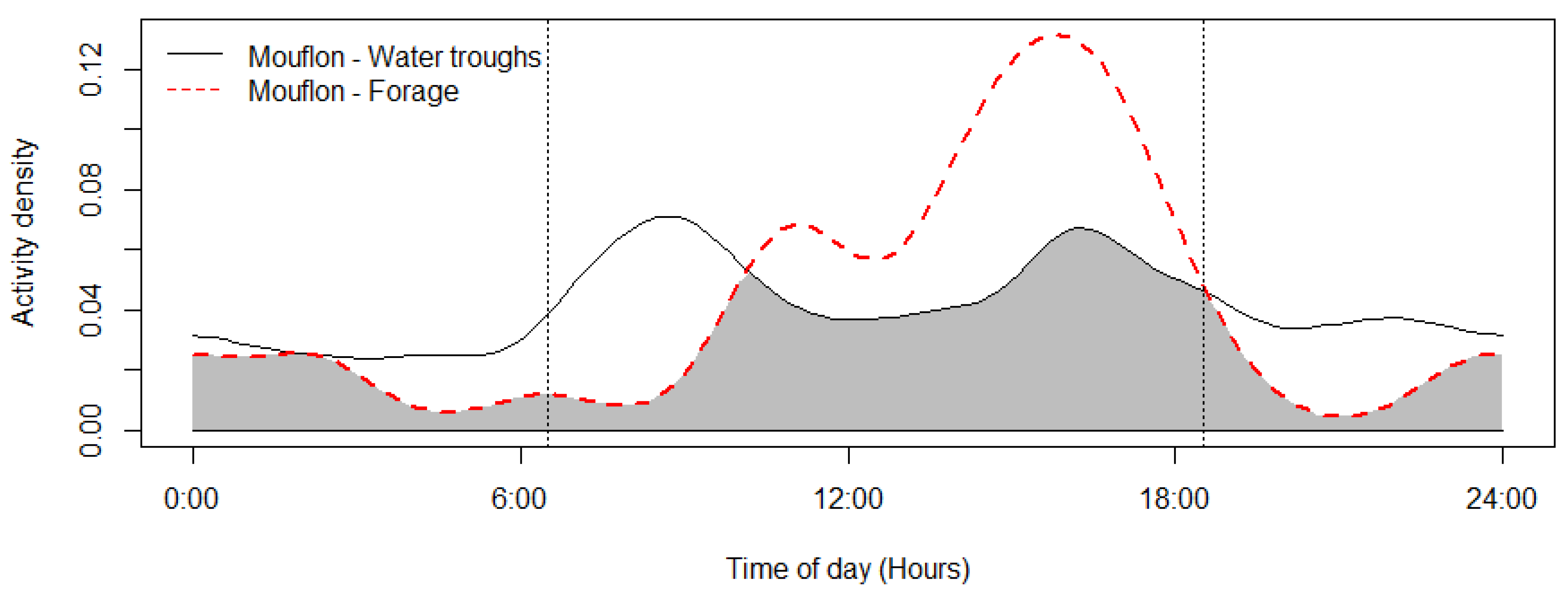

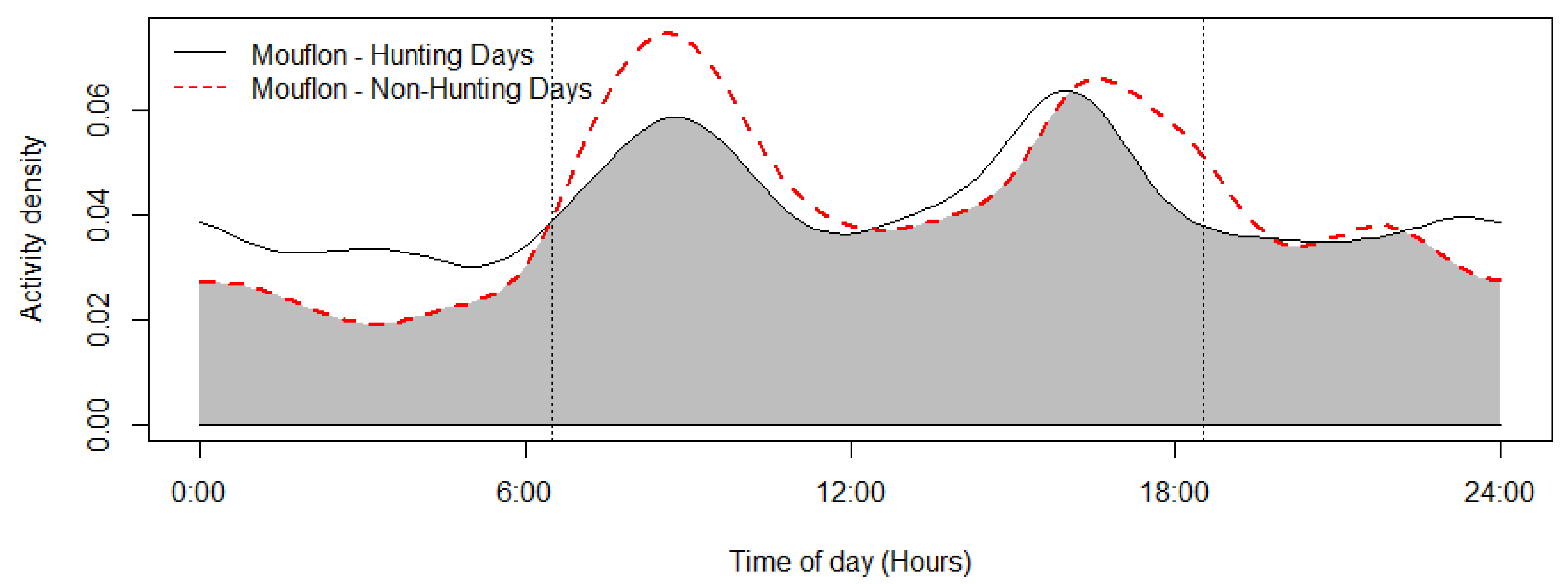
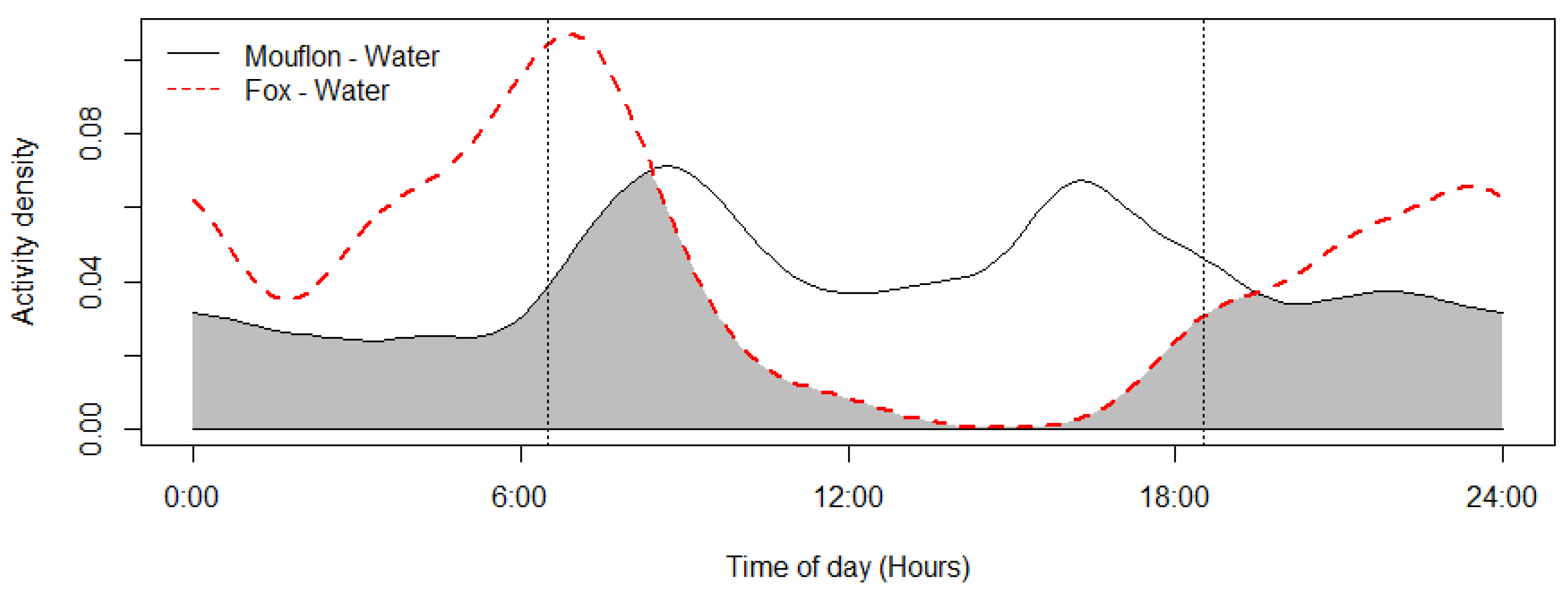
| Site Name | Site Code | Location | Survey Period | Survey Effort (Days) |
|---|---|---|---|---|
| Apo Orkontas | AO | Water trough | 26 September 2017—9 March 2018 | 164 |
| Artratsa | AR | Water trough | 2 September 2017–16 October 2017 | 44 |
| Den of Foxes | DF | Water trough | 21 November 2017–9 March 2018 | 108 |
| Dromonas | DR | Water trough | 16 November 2017–15 December 2017 | 29 |
| Kokinokremmos | KK | Water trough | 31 October 2017–9 March 2018 | 129 |
| Koriftos | KR | Water trough | 1 November 2017–9 March 2018 | 128 |
| Selladi Arnion | SA | Water trough | 18 December 2017–9 March 2018 | 81 |
| Selladi Voullas | SV | Water trough | 1 November 2017–9 March 2018 | 128 |
| Tripilos | TR | Water trough | 23 December 2017–9 March 2018 | 76 |
| Xeromoutas | XM | Water trough | 30 October 2017–9 March 2018 | 130 |
| Barisia | VA | Forage area | 20 January 2018–9 March 2018 | 48 |
| Kotziakari | KZ | Forage area | 31 January 2018–21 February 2018 | 21 |
| Potamos Kampou | PK | Forage area | 18 December 2017–9 March 2018 | 81 |
| Psilo | PS | Forage area | 18 December 2017–31 January 2018 | 44 |
| Xeros | XS | Forage area | 21 February 2018–9 March 2018 | 16 |
| Species/Site Code * | AO | AR | DF | DR | KK | KR | SA | SV | TR | XM | Total |
|---|---|---|---|---|---|---|---|---|---|---|---|
| Blackbird (Turdus merula) | 5 | 5 | |||||||||
| Chukar partridge (Alectoris chukar) | 5 | 2 | 1 | 1 | 1 | 10 | |||||
| Coal tit (Periparus ater) | 1 | 2 | 1 | 4 | |||||||
| Common kestrel (Falco tinnunculus) | 1 | 1 | |||||||||
| Common woodpigeon (Columba palumbus) | 107 | 34 | 4 | 10 | 1 | 76 | 29 | 261 | |||
| Eurasian jay (Garrulus glandarius) | 1 | 14 | 14 | 16 | 8 | 53 | |||||
| European robin (Erithacus rubecula) | 1 | 1 | 2 | ||||||||
| Greenfinch (Chloris chloris) | 3 | 3 | 3 | 9 | |||||||
| Hawfinch (Coccothraustes coccothraustes) | 1 | 1 | |||||||||
| Song thrush (Turdus philomelos) | 1 | 1 | 3 | 5 | |||||||
| Unidentified bird species | 1 | 1 | 2 | 6 | 1 | 1 | 12 | ||||
| Brown hare (Lepus europaeus cyprius) | 3 | 1 | 2 | 1 | 7 | ||||||
| Cyprus mouflon (Ovis gmelini ophion) | 226 | 163 | 114 | 21 | 21 | 7 | 3 | 555 | |||
| Red fox (Vulpes vulpes) | 1 | 3 | 19 | 2 | 6 | 11 | 4 | 2 | 48 | ||
| Dog (Canis familiaris) | 1 | 10 | 2 | 1 | 14 |
| Site Code * | Detections/Day | Total Events (Overall Detections/Day) | ||||||
|---|---|---|---|---|---|---|---|---|
| Sept. | Oct. | Nov. | Dec. | Jan. | Feb. | Mar. | ||
| AO | 0.00 | 0.74 | 4.27 | 0.03 | 0.00 | 0.00 | 0.00 | 152 (0.93) |
| AR | 3.07 | 0.00 | - | - | - | - | - | 89 (2.02) |
| DF | - | - | 0.00 | 0.00 | 0.00 | 0.00 | 0.00 | 0 (0.00) |
| DR | - | 0.00 | 0.00 | - | - | - | 0 (0.00) | |
| KK | - | 3.00 | 2.7 | 0.1 | 0.00 | 0.00 | 0.00 | 87 (0.67) |
| KR | - | - | 0.53 | 0.00 | 0.00 | 0.00 | 0.00 | 16 (0.13) |
| SA | - | - | - | 0.00 | 0.00 | 0.00 | 0.00 | 0 (0.00) |
| SV | - | - | 0.47 | 0.1 | 0.00 | 0.04 | 0.00 | 18 (0.14) |
| TR | - | - | - | 0.00 | 0.19 | 0.00 | 0.00 | 6 (0.08) |
| XM | - | 0.00 | 0.03 | 0.06 | 0.00 | 0.00 | 0.00 | 3 (0.03) |
| Total events | 91 | 26 | 240 | 9 | 6 | 1 | 0 | 373 (mean 0.4) |
| Temperature (°C) | 25.5 | 22 | 17.7 | 15.1 | 13.5 | 14.8 | 15.8 | - |
| Rainfall (mm) | 0 | 10.3 | 2.2 | 37.1 | 99.3 | 68.5 | 0 | - |
| Month | Independent Detections | % Solitary | Solitary Events * (n) | Group Size (All) | Group Size (excl. Solitary) | ||||
|---|---|---|---|---|---|---|---|---|---|
| AM | AF | YM | J | Unk | |||||
| September | 91 | 63.7% | 40 | 16 | - | - | 2 | 2 ± 1.71 | 3.76 ± 1.79 |
| October | 26 | 42.3% | 8 | 1 | - | 1 | 1 | 2.31 ± 1.32 | 3.27 ± 0.93 |
| November | 240 | 82.5% | 151 | 19 | 11 | - | 17 | 1.33 ± 0.86 | 2.9 ± 1.13 |
| December | 9 | 100% | 9 | - | - | - | - | 1 | - |
| January | 6 | 100% | 6 | - | - | - | - | 1 | - |
| February | 1 | 100% | - | 1 | - | - | - | 1 | - |
| March | - | - | - | - | - | - | - | - | - |
| Site Code * | Group Size | Total Detections |
|---|---|---|
| AO | 1.6 ± 1.1 | 152 |
| AR | 2.0 ± 1.7 | 91 |
| DF | - | 0 |
| DR | - | 0 |
| KK | 1.2 ± 0.7 | 87 |
| KR | 1.3 ± 0.6 | 16 |
| SA | - | 0 |
| SV | 1.1 ± 0.2 | 18 |
| TR | 1 | 6 |
| XM | 1 | 3 |
| Variables | Estimate | SE * | z-Value | Pr(>|z|) ** |
|---|---|---|---|---|
| intercept (βο) | −6.726 | 2.219 | 2.089 | 0.037 |
| distance to roads (log) | −1.384 | 0.451 | 3.067 | 0.002 |
| temperature (24 h max) | 0.488 | 0.063 | 7.806 | <0.0001 |
| time of day—evening | 0.382 | 0.173 | 2.205 | 0.027 |
| time of day—late morning | 0.712 | 0.163 | 4.355 | <0.0001 |
| time of day—midday | 0.644 | 0.165 | 3.893 | <0.0001 |
| precipitation (past 7 days) | 0.015 | 0.012 | 1.187 | 0.235 |
| distance to terrace/cliff (log) | −0.117 | 0.245 | 0.476 | 0.634 |
| precipitation (24 h) | −0.017 | 0.042 | 0.403 | 0.687 |
| Variables | Estimate | SE * | z-Value | Pr(>|z|) ** |
|---|---|---|---|---|
| intercept (βο) | −6.07 | 4.912 | 1.226 | 0.220 |
| distance to roads (log) | −1.729 | 0.592 | 2.899 | 0.004 |
| distance to terrace/cliff (log) | −0.455 | 0.334 | 1.350 | 0.177 |
| temperature (mean 24 h max) | 0.694 | 0.139 | 4.939 | <0.0001 |
| predator encounter rate | 1.237 | 0.734 | 1.67 | 0.095 |
| southern exposure | 5.018 | 3.032 | 1.643 | 0.1 |
Publisher’s Note: MDPI stays neutral with regard to jurisdictional claims in published maps and institutional affiliations. |
© 2022 by the authors. Licensee MDPI, Basel, Switzerland. This article is an open access article distributed under the terms and conditions of the Creative Commons Attribution (CC BY) license (https://creativecommons.org/licenses/by/4.0/).
Share and Cite
Eliades, N.-G.H.; Astaras, C.; Messios, B.V.; Vermeer, R.; Nicolaou, K.; Karmiris, I.; Kassinis, N. Artificial Water Troughs Use by the Mountain Ungulate Ovis gmelini ophion (Cyprus Mouflon) at Pafos Forest. Animals 2022, 12, 3060. https://doi.org/10.3390/ani12213060
Eliades N-GH, Astaras C, Messios BV, Vermeer R, Nicolaou K, Karmiris I, Kassinis N. Artificial Water Troughs Use by the Mountain Ungulate Ovis gmelini ophion (Cyprus Mouflon) at Pafos Forest. Animals. 2022; 12(21):3060. https://doi.org/10.3390/ani12213060
Chicago/Turabian StyleEliades, Nicolas-George Homer, Christos Astaras, Belle Verheggen Messios, Rob Vermeer, Kostas Nicolaou, Ilias Karmiris, and Nicolaos Kassinis. 2022. "Artificial Water Troughs Use by the Mountain Ungulate Ovis gmelini ophion (Cyprus Mouflon) at Pafos Forest" Animals 12, no. 21: 3060. https://doi.org/10.3390/ani12213060





